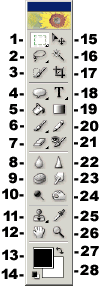Photoshop Elements 2 Lasso
Photoshop Elements 2 Lasso |
|
|
Used for making selections |
|
  |
Please note that the magnetic lasso has its own page. Drag with the [regular] lasso tool to make freehand selections. You can also hold down Alt, and click where corners would be if you want to make straight-edged selections. Holding down Alt toggles to the polygonal lasso. You can go back and forth between the two in the course of making a selection. When the desired shape is made, and closed (the end point is over the start point), releasing the mouse button, (and the Alt key, if in use) will complete the selection. If you release the mouse button before the shape is closed, the selection will complete itself with a straight line. Note – if your Alt key does not appear to be working in Elements, you may have another program running in the background that has taken over that key. GuruNet (Atomica) and FlySwat are two such applications. Uninstall them, or reassign the hot key in those programs to regain use of the Alt key in Elements. To use the polygonal lasso alone, select it and then click on corner points. Don’t drag. Complete the selection by clicking on the start point to close the shape. Toggle to the regular lasso by pressing the Alt key and dragging. While making a selection, you can remove the most recent portion of your outline by pressing Delete and backtracking. Existing selections can be added to, subtracted from, or intersected to modify the selection outline. This is done by choosing one of the selection type buttons on the tool’s options bar (see illustration, below). If you use the add selection option, the new selection you draw will be merged with the old. Overlaps will not affect the resulting selection. If you choose the subtract selection button, the new selection you drag will disappear the minute you complete the selection, along with any part of the old selection that was overlapped by it. If you choose the overlapping option, only the outline of the overlapping parts of the selections will remain when you complete the second selection. The keyboard shortcut key for this tool is the letter L. Hold down the Shift key while pressing the shortcut key to cycle through the lasso tools. |
|
The illustration below, is the lasso tool’s options bar. If you want a softer, blended edge on your selection, enter a value in the Feather box, usually from 2-5 pixels, but you can enter as much as you like. Be aware that if you intend to move the selection, colors from the current location will be in the feathering. The second illustration, below, is a numbered, larger scale illustration of the buttons from the left end of the options bar which determine how the selection you draw will interact with any existing, active selections. They are:
|
|
 |
|
|
If you have doodled with a tool’s options and want to get back to the default settings, click that tool’s icon at the far left end of its options bar. Choose either Reset Tool to reset only the current tool, or Reset All Tools to restore default settings to every tool. Please note that all descriptions, and illustrations featured refer to files which are in Photoshop’s .psd format, and which are in RGB color mode. Other file formats, and color modes may generate different options. Some Photoshop features are not available for images not in .psd format, or RGB color mode. To find what color mode your image is in, choose Image > Mode.
|
|



Comments